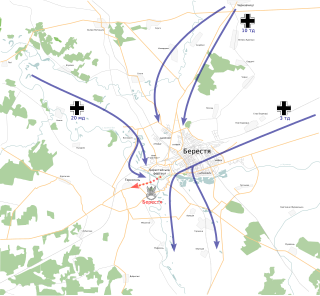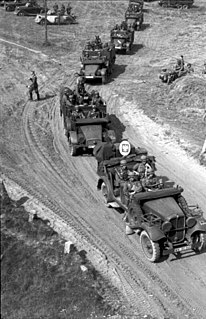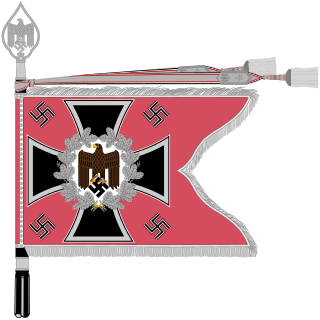
The 1st Panzer-Division was an armoured division in the German Army during World War II.

The Battle of Brześć Litewski was a World War II battle involving German and Polish forces that took place between 14 and 17 September 1939, near the town of Brześć Litewski. After three days of heavy fights for the stronghold in the town of Brześć, the Germans captured the fortress and the Poles withdrew.
The 1st Infantry Division, was one of the original infantry divisions of the Reichswehr and Wehrmacht that served throughout World War II.

The 10th Panzer Division was an armoured division in the German Army, the Heer, during World War II, established in March 1939.

A Panzer division was one of the armored (tank) divisions in the army of Nazi Germany during World War II. Panzer divisions were the key element of German success in the blitzkrieg operations of the early years of World War II. Later the Waffen-SS formed its own panzer divisions, and even the Luftwaffe fielded an elite panzer division: the Hermann Göring Division.
The Fallschirm-Panzer-Division 1. Hermann Göring was a German Luftwaffe armoured division. The HG saw action in France, North Africa, Sicily, Italy and on the Eastern Front during World War II. The division began as a battalion-sized police unit in 1933. Over time it grew into a regiment, brigade, division, and finally was combined with the Parachute-Panzergrenadier Division 2 Hermann Göring on 1 May 1944 to form a Panzer corps under the name Reichsmarschall. It surrendered to the Soviet Army near Dresden on 8 May 1945.

The 3rd Light Division was raised in November 1938. In 1939 it fought in the Invasion of Poland. On 4 September 1939, soldiers from the division entered the region of Katowice where they met resistance from the local Polish population. In retribution 80 Polish prisoners of war were gathered in Kosciuszko Square by German soldiers and executed.

The 6th Panzer Division was an armoured division in the German Army, the Heer, during World War II, established in October 1939.

The 12th Panzer Division was an armoured division in the German Army, established in 1940.

Panzerwaffe, later also Panzertruppe refers to a command within the Heer of the German Wehrmacht, responsible for the affairs of panzer (tank) and motorized forces shortly before and during the Second World War.

The 4th Panzer Division was an armored division in the Army of Nazi Germany.

The Battle of Mława, otherwise known as the Defence of the Mława position, took place to the north of the town of Mława in northern Poland between 1 and 3 September 1939. It was one of the opening battles of the Invasion of Poland and World War II in general. It was fought between the forces of the Polish Modlin Army under General Krukowicz-Przedrzymirski and the German 3rd Army under General Georg von Küchler.

The Volhynian Cavalry Brigade was a Polish cavalry brigade, which saw action against the invading Germans during the Invasion of Poland, a part of World War II. Raised from recruits in the area of Wołyń, the division was posted to the Łódź Army. During several desperate counter-attacks, the brigade suffered heavy casualties near Łódź. It was commanded by Colonel Julian Filipowicz. Most notably, the unit took part in one of the first battles of the German invasion of Poland, the battle of Mokra.
The German 273rd Reserve Panzer Division was a reserve army division. After the Battle of Kursk the German 273rd Reserve Panzer Division was used for augmenting of 11th Panzer Division, whereas their remaining forces were shifted to the Italian front.

The 10th Cavalry Brigade was a Polish military unit in World War II. It was the only fully operational Polish motorized infantry unit during the Invasion of Poland, as Warsaw Armoured Motorized Brigade was not completed by September 1, 1939.
The 19th Panzer Division was an armoured division in the German Army, the Wehrmacht, during World War II. It was created from the 19th Infantry Division.
Wilhelm von Apell was a German general in the Wehrmacht during World War II who commanded the 22nd Panzer Division. He was a recipient of the Knight's Cross of the Iron Cross of Nazi Germany.
The Panzer Division Jüterbog was an armoured division of the Wehrmacht during World War II. Created on 20 February 1945, it was active for a short period of time.












